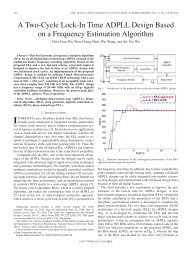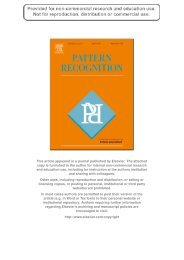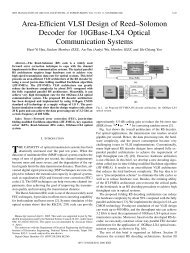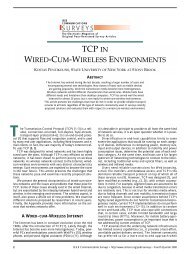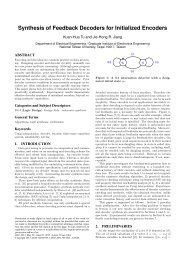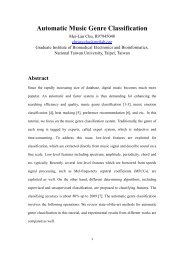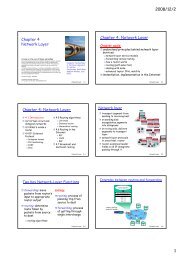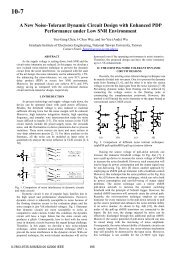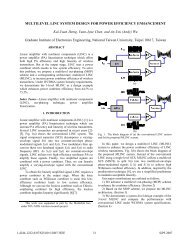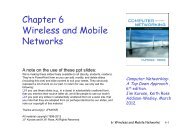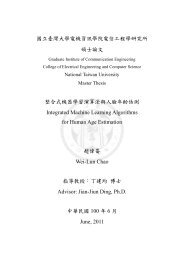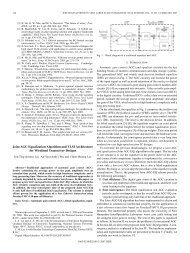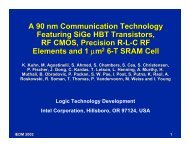On [n, n - 1] convolutional codes with low trellis complexity ...
On [n, n - 1] convolutional codes with low trellis complexity ...
On [n, n - 1] convolutional codes with low trellis complexity ...
You also want an ePaper? Increase the reach of your titles
YUMPU automatically turns print PDFs into web optimized ePapers that Google loves.
42 IEEE TRANSACTIONS ON COMMUNICATIONS, VOL. 50, NO. 1, JANUARY 2002TABLE IIIGOOD (5,4) CONVOLUTIONAL CODESProof: In case that, thenfor any -column permutation . We now need to find a permutationwhich leads to the largest or equivalently the least.For,wehave. Thus for any , 1 ,where the equality holds if is the permutation given in (6).Consider the case of . Suppose that ,that implies 0. Clearly,
TANG AND LIN: LOW TRELLIS COMPLEXITY 43TABLE IVGOOD (6,5) CONVOLUTIONAL CODESis in but not in and is in but notin . Let be the permutation that switches the -thand the -th columns. Then, and. With this , the resultant offset state<strong>complexity</strong> profile ( ) satisfies 1,1 and for other than and1. As long as , similar processescan be continued. Since is finite, these processes can notlast forever. Therefore we may assume .Apermutation which leads to the largest or equivalently thelargest number of1’s is preferred. Since1 and , then1 1, where theequality holds if is the permutation given in (6).Example: Consider an (8,7,4) <strong>convolutional</strong> codeminimal encoder1 1 1 1 0 0 0 00 0 0 0 1 1 1 10 0 1 1 1 1 0 01 0 0 1 0 1 1 00 0 2 0 2 0 1 10 1 2 0 0 0 0 12 0 4 4 0 0 0 1<strong>with</strong>The minimal encoder for is (26,32,3,17,5,11,20,34).The components in both and are representedin octal form. The state <strong>complexity</strong> profile of either or(7)
44 IEEE TRANSACTIONS ON COMMUNICATIONS, VOL. 50, NO. 1, JANUARY 2002TABLE VGOOD (7,6) CONVOLUTIONAL CODESis 4 5 5 5 5 5 4 4 . The associated andare 00 111 100 and 11 000 011 , respectively.For ,wehave = 2 3 4 5 and= 0 1 6 7 . Hence an optimal permutationfor the reciprocal dual code is 2 3 4 5 0 1 6 7 .According to Theorem 1, is also an optimal permutation for. The state <strong>complexity</strong> profile for the equivalent code of eitheror is 4 4 4 4 3 4 4 4 that is better than that of theoriginal code. The minimal <strong>trellis</strong> modules for such optimallyequivalent <strong>codes</strong> of and are shown in Figs. 1 and 2,respectively.V. GOOD ( 1) CONVOLUTIONAL CODESIn applying the Viterbi algorithm (VA) to decoding a <strong>convolutional</strong>code, the decoding <strong>complexity</strong> is sometimes measuredby the number of vertices per minimal <strong>trellis</strong> module or sometimesby the number of branches per minimal <strong>trellis</strong> module,where each branch corresponds to one code bit. In Section IV,we have already shown that for an ( 1) <strong>convolutional</strong> codein case the decoding <strong>complexity</strong> is measured by the numberof vertices, then a large is desired. In the fol<strong>low</strong>ing, we considerthe case that the decoding <strong>complexity</strong> is measured by thenumber of branches. For an ( 1) <strong>convolutional</strong> code <strong>with</strong>memory size , it has a reciprocal dual , which is an ( 1)code <strong>with</strong> indices and .For , there is only asingle branch emanating from each state at depth forand there are two branches emanating from each state at depthfor , while there are two branches merging at eachstate at depth for 1 and there is only a singlebranch entering each state at depth for 1. Accordingto the observation given at the end of Section III, for ,there are two branches emananating from each state at depthfor and there is only a single branch emanating fromeach state at depth for . Let , 0 1 1be the offset state <strong>complexity</strong> profile of . Suppose that0. Then, 0 for andwhile 1 for . Hence, the decoding<strong>complexity</strong> can be calculated to be1 2 2 2 2 2 2 1 2(8)
TANG AND LIN: LOW TRELLIS COMPLEXITY 45TABLE VIGOOD (8,7) CONVOLUTIONAL CODESSuppose that 0. Then, 0 forand while 1 for. Hence, the decoding <strong>complexity</strong> can be calculatedto be(9)We see that a large is desired for both measures of decoding<strong>complexity</strong>. Hence, is a good measure of decoding <strong>complexity</strong>for an ( 1) code.If we decode an ( 1) binary <strong>convolutional</strong> code <strong>with</strong>memory size by applying VA to the conventional <strong>trellis</strong>, thedecoding <strong>complexity</strong> measured by the number of branches
46 IEEE TRANSACTIONS ON COMMUNICATIONS, VOL. 50, NO. 1, JANUARY 2002TABLE VIISOME OF THE BEST KNOWN (n; n 0 1) PUNCTURED CODES SHOWN IN [7](each branch corresponds to 1 code bit) per <strong>trellis</strong> module is2 . For an ( 1) binary punctured code <strong>with</strong>memory size obtained from a certain <strong>convolutional</strong> code,the decoding <strong>complexity</strong> measured by the number of branchesper <strong>trellis</strong> module (each branch corresponds to 1 code bit) is2 . The advantage of decoding for ( 1) punctured<strong>convolutional</strong> code over ( 1) <strong>convolutional</strong> code usingconventional <strong>trellis</strong> is clear. However, we note that comparedto an ( 1) punctured <strong>convolutional</strong> code for 1,an ( 1) <strong>convolutional</strong> code <strong>with</strong> minimal <strong>trellis</strong> modulehas the same decoding <strong>complexity</strong> for 1 and has <strong>low</strong>erdecoding <strong>complexity</strong> for 1 in case the decoding <strong>complexity</strong>measured by the number of branches per <strong>trellis</strong> moduleand each branch corresponds to one code bit.For a coding system, <strong>low</strong> decoding <strong>complexity</strong> as well as <strong>low</strong>error rate is desired. The error performance of an ( ) <strong>convolutional</strong>code <strong>with</strong> free distance can be estimated by itscode weight spectrum and information weight spectrum whichare, respectively, represented by and , where is the totalnumber of code sequences <strong>with</strong> weight 1 and isthe total number of information bits associated to the code sequences<strong>with</strong> weight 1. In case the code is appliedover a symmetric and memoryless channel and maximum-likelihooddecoding is used, the first event error probability of thecoding system can be estimated by 1and the symbol error probability can be estimated by1 1 , where is the probabilityof erroneously decoding a code sequence into a give code sequencewhich is separated by a distance of . We see that forachieving <strong>low</strong> error rate, small and or “thin” weight spectraare desired. In [20], an algorithm called FAST algorithm is proposedto efficiently compute the weight spectra of <strong>convolutional</strong><strong>codes</strong>.With the aid of Theorem 1, 2, FAST algorithm and computer,we are able to search for good ( 1) <strong>convolutional</strong> <strong>codes</strong>.For the given , and 1, we search for ( 1)<strong>codes</strong> which have the currently best weight spectra. For thegiven , and , we exhaustively check all the possible ( 1)<strong>codes</strong>. For each ( 1) code to be checked, we randomly choosea generator matrix <strong>with</strong> -property for the associated reciprocaldual ( 1) code and compute the associated weightspectra. The <strong>codes</strong> <strong>with</strong> the currently best weight spectra foundin this search are listed in Tables I–VI for 3 4 5 6 7, and8, respectively. For comparison, we also list some of the bestknown punctured <strong>codes</strong> in Table VII. We can see many <strong>codes</strong>in these tables are better than punctured <strong>convolutional</strong> <strong>codes</strong> ofthe same code rate and memory size [2], [3], [7] by either <strong>low</strong>erdecoding <strong>complexity</strong> or better weight spectra. Note that we only
TANG AND LIN: LOW TRELLIS COMPLEXITY 47randomly choose one of the many possible generator matrices<strong>with</strong> -property for a given ( 1) code. It is likely thatthere exist better ( 1) <strong>codes</strong> if we exhaustively checkingall the possible generator matrices.VI. CONCLUDING REMARKSIn this paper, we show that the state <strong>complexity</strong> profiles of a<strong>convolutional</strong> code and the reciprocal of its dual code are identicalif minimal encoders for both <strong>codes</strong> are used. We also proposean optimum permutation for any given ( 1) binary<strong>convolutional</strong> code that will yield an equivalent code <strong>with</strong> the<strong>low</strong>est state <strong>complexity</strong>. Moreover, we find many good ( 1)<strong>convolutional</strong> <strong>codes</strong> which are superior to the popular punctured<strong>convolutional</strong> <strong>codes</strong> by either <strong>low</strong>er decoding <strong>complexity</strong>or better weight spectra. The code search used here is not complete.Hence, it is likely that there exist <strong>codes</strong> better than thosefound in this code search. In fact, how to design a method toefficiently check the possible encoders under the restriction of-property for the reciprocal of the dual code of an ( 1) codeis an interesting problem.[11] J. L. Massey, “Foundation and methods of channel encoding,” in Proc.Int. Conf. Information Theory and Systems, vol. 65, Berlin, Germany,1978, pp. 148–157.[12] A. D. Kot and C. Leung, “<strong>On</strong> the construction and dimensionality oflinear block code <strong>trellis</strong>es,” in IEEE Int. Symp. Inform. Theory, San Antonio,TX, 1993.[13] G. D. Forney Jr, “Dimension/length profiles and <strong>trellis</strong> <strong>complexity</strong>of linear block <strong>codes</strong>,” IEEE Trans. Inform. Theory, vol. 40, pp.1741–1752, Nov. 1994.[14] R. J. McEliece, “<strong>On</strong> the BCJR <strong>trellis</strong> for linear block <strong>codes</strong>,” IEEETrans. Inform. Theory, vol. 42, pp. 1072–1092, July 1996.[15] A. Vardy and F. R. Kschischang, “Proof of a conjecture of McEliece regardingthe expansion index of the minimal <strong>trellis</strong>,” IEEE Trans. Inform.Theory, vol. 42, pp. 2027–2034, Nov. 1996.[16] V. Sidorenko and V. Zyablov, “Decoding of <strong>convolutional</strong> <strong>codes</strong> using asyndrome <strong>trellis</strong>,” IEEE Trans. Inform. Theory, vol. 40, pp. 1663–1666,Sept. 1994.[17] R. J. McEliece and W. Lin, “The <strong>trellis</strong> <strong>complexity</strong> of <strong>convolutional</strong><strong>codes</strong>,” IEEE Trans. Inform. Theory, vol. 42, pp. 1855–1864, Nov. 1996.[18] P. Piret, Convolutional Codes. Cambridge, MA: MIT Press, 1988.[19] G. D. Forney Jr, “Convolutional <strong>codes</strong> I: Algebraic structure,” IEEETrans. Inform. Theory, vol. IT-16, pp. 720–738, Nov. 1970.[20] M. Cedervall and R. Johannesson, “A fast algorithm for computing distancespectrum of <strong>convolutional</strong> <strong>codes</strong>,” IEEE Trans. Inform. Theory,vol. 35, pp. 1146–1159, Nov. 1989.REFERENCES[1] A. J. Viterbi, “Error bounds for <strong>convolutional</strong> <strong>codes</strong> and an asymptoticallyoptimum decoding algorithm,” IEEE Trans. Inform. Theory, vol.IT-13, pp. 260–269, Apr. 1967.[2] J. B. Cain, G. C. Clark Jr, and J. M. Geist, “Punctured <strong>convolutional</strong><strong>codes</strong> of rate (n; n01) and simplified maximum likelihood decoding,”IEEE Trans. Inform. Theory, vol. 25, pp. 97–100, Jan. 1979.[3] P. J. Lee, “Constructions of rate (n 0 1)=n punctured <strong>convolutional</strong><strong>codes</strong> <strong>with</strong> minimal required SNR criterion,” IEEE Trans. Commun.,vol. 36, pp. 1171–1173, Oct. 1988.[4] D. Haccoun and G. Begin, “High rate punctured <strong>convolutional</strong> <strong>codes</strong> forViterbi and sequential decoding,” IEEE Trans. Commun., vol. 37, pp.1113–1125, Nov. 1989.[5] G. Begin and D. Haccoun, “High rate punctured <strong>convolutional</strong> <strong>codes</strong>:Structure properties and construction construction technique,” IEEETrans. Commun., vol. 37, pp. 1381–1385, Dec. 1989.[6] M.-G. Kim, “<strong>On</strong> systematic punctured <strong>convolutional</strong> <strong>codes</strong>,” IEEETrans. Commun., vol. 45, pp. 133–139, Feb. 1997.[7] I. E. Bocharova and B. D. Kudryashov, “Rational rate punctured <strong>convolutional</strong><strong>codes</strong> for soft-decision Viterbi decoding,” IEEE Trans. Inform.Theory, vol. 43, pp. 1305–1313, July 1997.[8] G. D. Forney Jr, “Coset <strong>codes</strong>—Part II: Binary lattices and related<strong>codes</strong>,” IEEE Trans. Inform. Theory, vol. 34, pp. 1152–1187, Sept.1988.[9] D. J. Muder, “Minimal <strong>trellis</strong>es for block <strong>codes</strong>,” IEEE Trans. Inform.Theory, vol. 34, pp. 1049–1053, Sept. 1988.[10] L. R. Bahl, J. Cocke, F. Jelinek, and J. Raviv, “Optimal decoding of linear<strong>codes</strong> for minimizing symbol error rate,” IEEE Trans. Inform. Theory,vol. IT-20, pp. 284–287, Mar. 1974.Hung-Hua Tang was born in Taipei, Taiwan, R.O.C.,in 1962. He received the B.S. degree in control engineeringfrom Chiao Tung University, R.O.C., in 1993and the M.S. and Ph.D. degrees, both in electrical engineering,from National Taiwan University,R.O.C.,in 1993 and 2001, respectively. His research interestsinclude coding theory and wireless communication.Mao-Chao Lin was born in Taipei, Taiwan, R.O.C.,on December 24, 1954. He recieved the Bachelorand Masters degrees, both in electrical engineering,from National Taiwan University,R.O.C., in 1977and 1979, respectively, and the Ph.D. degree inelectrical engineering from University of Hawaii in1986.From 1979 to 1982, he was an Assistant Scientistof Chung-Shan Institute of Science and Technologyat Lung-Tan, Taiwan, R.O.C. He is currently <strong>with</strong> NationalTaiwan University, as a Professor <strong>with</strong> the Departmentof Electrical Engineering. Since 2000, he has been the chairman ofGraduate Institute of Communication Engineering, National Taiwan University.His research interests include coding theory and ARQ techniques.


![On [n, n - 1] convolutional codes with low trellis complexity ...](https://img.yumpu.com/45854741/1/500x640/on-n-n-1-convolutional-codes-with-low-trellis-complexity-.jpg)
